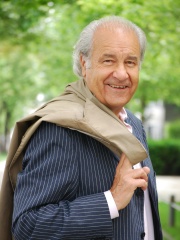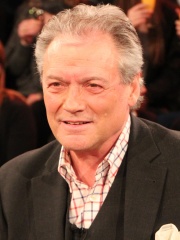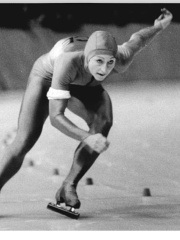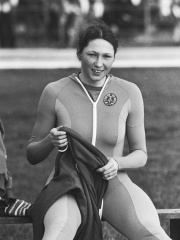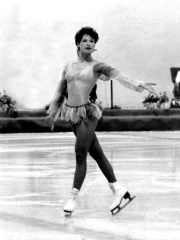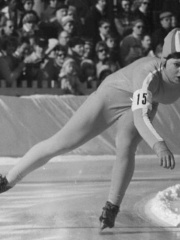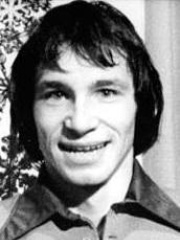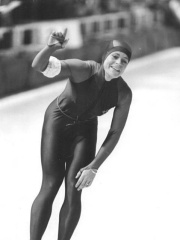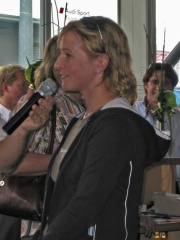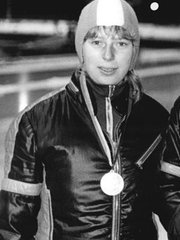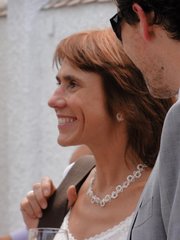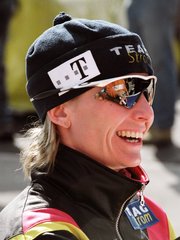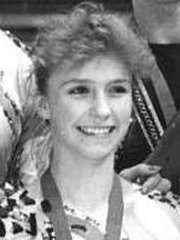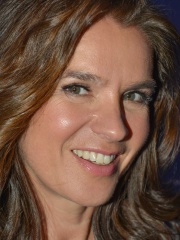
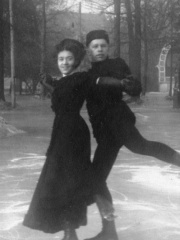
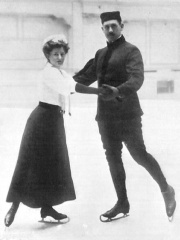
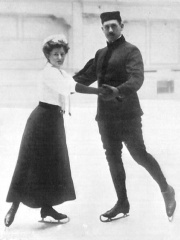
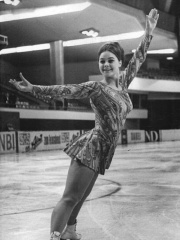
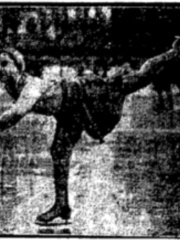
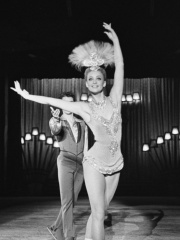

The Most Famous
SKATERS from Germany
This page contains a list of the greatest German Skaters. The pantheon dataset contains 483 Skaters, 41 of which were born in Germany. This makes Germany the birth place of the 5th most number of Skaters behind Netherlands, and Canada.
Top 10
The following people are considered by Pantheon to be the top 10 most legendary German Skaters of all time. This list of famous German Skaters is sorted by HPI (Historical Popularity Index), a metric that aggregates information on a biography's online popularity. Visit the rankings page to view the entire list of German Skaters.

1. Katarina Witt (b. 1965)
With an HPI of 63.16, Katarina Witt is the most famous German Skater. Her biography has been translated into 39 different languages on wikipedia.
Katarina Witt (German pronunciation: [kataˈʁiːna vɪt], ; born 3 December 1965) is a German former figure skater. A two-time Olympic champion, Witt is regarded as one of the greatest ladies' singles figure skaters of all time. Her Laureus profile states that "she is remembered most for her overall athleticism, her charismatic appeal and her glamorous image on the ice." Witt won the first of her two Olympic gold medals for East Germany at the 1984 Sarajevo Olympics, before winning a second at the 1988 Calgary Olympics. She is one of only two skaters to defend a ladies' singles Olympic title, the other being Norwegian Sonja Henie. Witt is a four-time World Champion (1984, 1985, 1987, 1988) and two-time World silver medalist (1982, 1986). She won six consecutive European Championships (1983–1988), a feat equalled only by Henie among female skaters. Between 1984 and 1988, Witt won ten gold medals in eleven major international events, making her one of the most successful figure skaters ever. Retiring from competitive skating after defending her Olympic title in 1988, Witt reappeared at the 1994 Winter Olympics where she represented a reunified Germany while skating a Robin Hood-themed program, a comeback performance which saw her receive the Goldene Kamera award. Since her subsequent retirement, Witt has worked in film and television.

2. Ludowika Jakobsson (1884 - 1968)
With an HPI of 59.58, Ludowika Jakobsson is the 2nd most famous German Skater. Her biography has been translated into 20 different languages.
Ludovika Antje Margareta Jakobsson-Eilers (née Eilers, 25 July 1884 – 1 November 1968) was a German-Finnish figure skater. Competing in pair skating with her husband Walter Jakobsson, she won the gold medal at the 1920 Summer Olympics, where she was the only German-born athlete, and became the oldest female figure skating Olympic champion. The pair also earned three world titles, in 1911, 1914 and 1923, and finished second and fifth at the 1924 and 1928 Olympics, respectively. Eilers also had some success in single skating, winning a bronze medal at the 1911 World Championships.

3. Heinrich Burger (1881 - 1942)
With an HPI of 59.32, Heinrich Burger is the 3rd most famous German Skater. His biography has been translated into 22 different languages.
Heinrich Burger (31 May 1881 – 27 April 1942) was a German figure skater. He competed in both singles and pair skating events. As a pair skater, he was Olympic champion and two-time World champion with Anna Hübler. Burger and Hübler were the first world champions and the first Olympic champions in pair skating. They never became European champions, because the European championships did not include a pairs competition until 1930. They skated for the club Müchener EV (Munich EV). According to figure skating historian James R. Hines, "Contemporary accounts recognize them for their strength and speed, noting that they always skated in perfect time with the music." Heinrich Burger was also a lawyer in Munich.

4. Anna Hübler (1885 - 1976)
With an HPI of 58.92, Anna Hübler is the 4th most famous German Skater. Her biography has been translated into 21 different languages.
Anna "Annie" Hübler (2 January 1885 – 5 July 1976) was a German pair skater, born in Munich. She was an Olympic champion and two-time World champion with skating partner Heinrich Burger. Hübler and Burger were the first World champions and the first Olympic champions in pairs figure skating. They never became European champions because the European championships did not include a pairs competition until 1930. They skated for the club Münchener EV (Munich EV). Hübler was the first female German Olympic champion. (The first woman to win an Olympic medal for Germany was the single skater Elsa Rendschmidt. She won silver in 1908.) After retiring from figure skating, Hübler became a singer and actress. She later owned a department store.
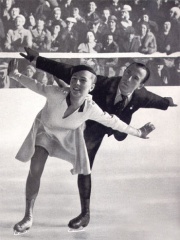
5. Ernst Baier (1905 - 2001)
With an HPI of 58.00, Ernst Baier is the 5th most famous German Skater. His biography has been translated into 22 different languages.
Ernst Baier (27 September 1905 in Zittau, Saxony, Germany – 8 July 2001 in Garmisch, Bavaria, Germany) was a German figure skater who competed in pair skating and single skating. He became Olympic pair champion in 1936 together with Maxi Herber. The duo also won several World and European championships. Ernst Baier skated for the club Berliner SC. He also enjoyed success as a single skater and won silvers at the European, World and Olympic games in singles. He competed at the European Championships in 1929, coming in seventh place, and again in 1930, coming in fifth place. He competed at the World Championships four times, between 1931 and 1934, and won two bronze medals and two silver medals. Skating with Herber, he won seven national titles, five European titles, and four World titles, in addition to their Olympic gold. The pair performed several side-by-side jumps, including side-by-side Axel jumps at the 1934 Championships, when they won a bronze medal, likely the first side-by-side Axels competed by a pair at an ISU championship. They also developed a 'Baier lift', which was similar to a twist lift but lacking a release of Herber into the air. They did not compete in 1935 due to an injury, but returned in 1936 and as figure skating historian James R. Hines put, "were unbeatable for the remainder of the prewar period". They won the gold medal at the Winter Olympics in 1936. Herber and Baier married after their skating career ended in 1940. They had three children and divorced in 1964. After World War II they skated in ice shows; they created their own, which was later sold to Holiday on Ice. He also worked as an architect and coach. They were elected to the World Figure Skating Hall of Fame in 1979. On 15 May 1965 he married the Swedish figure skater Birgitta Wennström (born 10 November 1935 in Enskede, Stockholm, Sweden) known by the stage name "Topsy" from Holiday on Ice together with her partner Steve. They had a daughter in 1968, but divorced in 1973. Some years later he remarried Maxi Herber, but they later divorced again.

6. Gabriele Seyfert (b. 1948)
With an HPI of 57.94, Gabriele Seyfert is the 6th most famous German Skater. Her biography has been translated into 20 different languages.
Gabriele "Gaby" Seyfert (later Rüger, then Messerschmidt, now Körner, born 23 November 1948) is a German former figure skater. She is a two-time World champion (1969, 1970), and the 1968 Olympic silver medalist. She is the first lady to successfully land a triple loop jump in competition.

7. Maxi Herber (1920 - 2006)
With an HPI of 57.32, Maxi Herber is the 7th most famous German Skater. Her biography has been translated into 19 different languages.
Maxi Herber (8 October 1920 – 20 October 2006) was a German figure skater who competed in pair skating and single skating. She remains the youngest figure skating Olympic champion (at the age of 15 years and 128 days) from when she won gold in pair skating together with Ernst Baier at the 1936 Winter Olympics. Born in Munich, Herber was also an accomplished single skater, winning the German nationals three times, from 1933 to 1935. She skated for the Münchner EV (Munich EV) club. Skating with Baier, she won seven national titles, five European titles, and four World titles, in addition to their Olympic gold. Herber later sold her Olympic gold medal and donated the money to survivors of the Holocaust. The pair performed several side-by-side jumps, including side-by-side Axel jumps at the 1934 Championships, likely the first side-by-side Axels competed by a pair at an ISU championship. They also developed a 'Baier lift', which was similar to a twist lift but lacking a release of Herber into the air. Herber and Baier married after their skating career ended in 1940. They had three children. After World War II they skated in ice shows; they created their own, which was later sold to Holiday on Ice. In 1964 they were divorced. She worked as a coach, then supported by public welfare and the "Deutsche Sporthilfe" (German Sport help organisation), she moved to Oberau near Garmisch-Partenkirchen in Bavaria. Some years later Herber and Baier remarried, but they divorced again. Herber suffered from Parkinson's disease. In 2000, she moved to the Lenzheim retirement home in Garmisch-Partenkirchen, where she held an exhibition of her watercolor paintings. She died in 2006 at age 86.

8. Marika Kilius (b. 1943)
With an HPI of 55.15, Marika Kilius is the 8th most famous German Skater. Her biography has been translated into 19 different languages.
Marika Kilius (German pronunciation: [maˈʁiːkaː ˈkiːli̯ʊs] ; born 24 March 1943) is a German former pair skater. With Hans-Jürgen Bäumler, she is a two-time Olympic silver medalist, a two-time World champion, and a six-time European champion. Earlier in her career, she competed with Franz Ningel.

9. Ria Baran (1922 - 1986)
With an HPI of 54.71, Ria Baran is the 9th most famous German Skater. Her biography has been translated into 18 different languages.
Ria Baran (German pronunciation: [ˈʁiːa baˈʁaːn] ; 2 November 1922 in Dortmund, Germany – 12 November 1986) was a German pair skater. She skated together with Paul Falk and twice became World champion and in 1952 Olympic champion. She was one of the oldest female figure skating Olympic champions. Ria Baran married Paul Falk during her active international figure skating. Therefore she is sometime listed as Ria Baran-Falk or Ria Falk. According to figure skating historian James R. Hines, they were known in the skating world as "the Falks". They were also world pair championships in roller skating. The pair skated for the club Düsseldorfer EG and had no coach. They came in fourth place at the German National Championships in 1940. Their career was curtailed by World War II; they won Nationals when they were reinstated in 1947. Until 1951, when they won the European Championships, Baran and Falk were not able to participate in international competitions because Germany was excluded from the international sport after the war. Also in 1951, they won the World Championships over Americans Karol Kennedy and Peter Kennedy. In 1952, they won their second European and World titles, as well as a gold medal at the Olympics. They were the first couple which performed side by side double jumps and they also invented the Lasso-Lift. Baran and Falk were never defeated in amateur competition. Between 1950 and 1952 Ria Baran was voted 3 times running as the female athlete of the year in Germany. After winning the Olympics in 1952 they turned pro and worked for Holiday on Ice. They were elected to the World Figure Skating Hall of Fame in 1993. Baran later worked as a secretary.

10. Paul Falk (1921 - 2017)
With an HPI of 54.17, Paul Falk is the 10th most famous German Skater. His biography has been translated into 17 different languages.
Paul Falk (German pronunciation: [paʊ̯l ˈfalk] ; 21 December 1921 – 20 May 2017) was a German pair skater. Born in Dortmund, Germany, he skated with Ria Baran and became two-time World champion and 1952 Olympic champion. Baran and Falk married during their active international figure skating. The pair skated for the club Düsseldorfer EG and had no coach. They came in fourth place at the German National Championships in 1940. Their career was curtailed by World War II; they won Nationals when they were reinstated in 1947. Until 1951, when they won the European Championships, Baran and Falk were not able to participate in international competitions because Germany was excluded from the international sport after the war. Also in 1951, they won the World Championships over Americans Karol Kennedy and Peter Kennedy. In 1952, they won their second European and World titles, as well as a gold medal at the Olympics. They were the first couple who performed side by side double jumps and they also invented the Lasso-Lift. Baran and Falk were never defeated in amateur competition. They were also World pair champions in roller skating. In 1951 Falk was voted the male athlete of the year in Germany. After winning the Olympics in 1952 they turned professional and worked for Holiday on Ice. Falk's profession outside athletics was as a precision mechanic; he was also "a prominent coach in Germany". In 1993 they were inducted into the World Figure Skating Hall of Fame. He died 8+1⁄2 months before Aliona Savchenko and Bruno Massot won the gold medal for pairs skating at the 2018 Winter Olympics.
People
Pantheon has 41 people classified as German skaters born between 1881 and 1992. Of these 41, 34 (82.93%) of them are still alive today. The most famous living German skaters include Katarina Witt, Gabriele Seyfert, and Marika Kilius. The most famous deceased German skaters include Ludowika Jakobsson, Heinrich Burger, and Anna Hübler. As of April 2024, 4 new German skaters have been added to Pantheon including Sylvia Albrecht, Anke Baier-Loef, and Sabine Völker.
Living German Skaters
Go to all RankingsKatarina Witt
1965 - Present
HPI: 63.16
Gabriele Seyfert
1948 - Present
HPI: 57.94
Marika Kilius
1943 - Present
HPI: 55.15
Manfred Schnelldorfer
1943 - Present
HPI: 53.69
Hans-Jürgen Bäumler
1942 - Present
HPI: 53.61
Christa Luding-Rothenburger
1959 - Present
HPI: 52.68
Karin Enke
1961 - Present
HPI: 52.54
Anett Pötzsch
1960 - Present
HPI: 51.95
Andrea Ehrig-Mitscherlich
1960 - Present
HPI: 51.51
Jan Hoffmann
1955 - Present
HPI: 51.35
Gunda Niemann-Stirnemann
1966 - Present
HPI: 50.70
Claudia Pechstein
1972 - Present
HPI: 50.51
Deceased German Skaters
Go to all RankingsLudowika Jakobsson
1884 - 1968
HPI: 59.58
Heinrich Burger
1881 - 1942
HPI: 59.32
Anna Hübler
1885 - 1976
HPI: 58.92
Ernst Baier
1905 - 2001
HPI: 58.00
Maxi Herber
1920 - 2006
HPI: 57.32
Ria Baran
1922 - 1986
HPI: 54.71
Paul Falk
1921 - 2017
HPI: 54.17
Newly Added German Skaters (2025)
Go to all RankingsSylvia Albrecht
1962 - Present
HPI: 47.77
Anke Baier-Loef
1972 - Present
HPI: 43.49
Sabine Völker
1973 - Present
HPI: 42.78
Mandy Wötzel
1973 - Present
HPI: 40.82
Overlapping Lives
Which Skaters were alive at the same time? This visualization shows the lifespans of the 7 most globally memorable Skaters since 1700.

